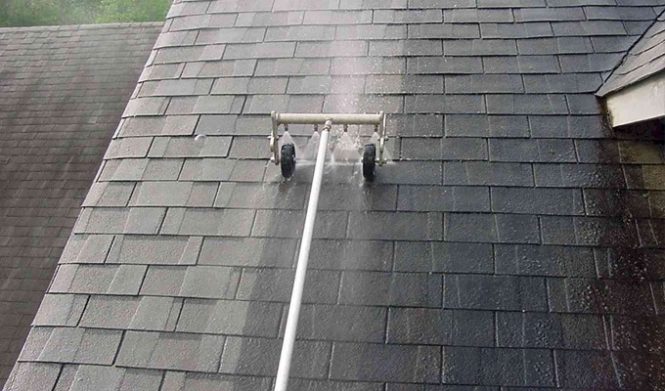

Roof moss removal DIY is a project that many homeowners undertake to improve their property’s aesthetics and maintain a healthy roof. Imagine your home with a pristine, moss-free roof—a visual improvement that boosts your property’s curb appeal and protects your investment. Roof moss, a common problem in many areas, can cause significant damage if left unchecked. This comprehensive guide will walk you through each step, from preparation to completion, of effectively tackling roof moss removal DIY. We’ll discuss the common problems, effective methods, and important safety considerations along the way. We’ll also provide valuable tips to prevent future moss growth, ensuring a long-lasting solution.
Understanding Roof Moss and Its Implications
Identifying Roof Moss
Roof moss is a common problem that arises when moisture and the right conditions for moss growth are present. Moss thrives in damp, shaded areas on roofs where it can establish itself firmly over time, creating a significant aesthetic concern. It can be difficult to spot early-stage moss growth, often only noticeable during prolonged periods of rain. This makes early detection of roof moss essential. Proper identification will assist in the development of the right solution.
Why Removing Roof Moss is Crucial
Roof moss can be more than just an eyesore; it can lead to significant structural damage over time. Accumulated moss retains moisture, which can lead to rot and weakening of the roofing materials. This often results in water damage and costly repairs that can potentially compromise structural integrity if neglected. Prompt roof moss removal is crucial to safeguarding your home’s long-term stability. A significant issue, especially in areas with high rainfall or prolonged damp periods, can lead to extensive roof damage.
Preparing for Roof Moss Removal DIY
Essential Safety Precautions
Safety should always be your top priority during any home improvement project, especially when working on your roof. The roof can be a dangerous place to work; falling hazards are a serious concern. Always use appropriate safety gear, including sturdy climbing equipment like harnesses and fall protection systems. This will prevent potential accidents that could result in serious injuries. Also, make sure to wear appropriate clothing and eye protection to ensure you are properly shielded.
Gathering Essential Tools and Supplies
Before beginning the moss removal process, ensure you have the necessary tools and materials. Essential tools may include a ladder, a stiff brush, a garden hose, or a pressure washer to remove the moss and other debris. Protective gear is also crucial, including safety glasses and gloves. Consider the type of roof you have to determine what the best tool is to use for cleaning.
Applying the Moss Removal Solution
Choosing the Right Removal Method
Several methods can be utilized for roof moss removal. You could use a stiff brush for manual removal, or a pressure washer for a more thorough clean. The choice of method will depend on the severity of the moss growth. For particularly stubborn moss, a specialized cleaning solution might be required. Always consult relevant resources or professionals for guidance on choosing the best method based on your roof type and moss conditions.
Applying the Cleaning Solution
Apply your chosen cleaning solution to the affected areas and allow adequate time to work. This depends on the solution’s nature and how it’s recommended to use. A professional will have specific instructions in cases of more specialized solutions. It is crucial to follow product instructions and ensure the moss is fully softened before proceeding with scrubbing or rinsing.
Cleaning and Rinsing
Thoroughly scrub the treated areas using the appropriate tools to remove the loosened moss and other debris. A pressure washer is suitable for more significant jobs or those that may require more force. Allow the roof to dry completely before proceeding with any further steps. This is an important detail as this is crucial for ensuring the removal solution works as effectively as intended. Drying times will vary based on product and weather conditions
Preventative Measures for Future Moss Growth
Identifying Underlying Causes
Identifying the underlying causes of moss growth is essential for preventing future issues. Factors like moisture, shade, and the type of roofing material can impact how susceptible a roof is to moss growth. Understanding the root causes of the problem will guide prevention strategies. This includes taking steps to address areas where water is prone to pooling.
Implementing Preventative Maintenance
Regular roof inspections can help you detect moss issues early on. A proactive approach includes preventing water damage or rot. This may involve gutter maintenance and making sure that water can flow appropriately. Addressing these issues early will prevent future issues. Regular maintenance can also improve roof integrity and durability.
Roof Moss Removal FAQs
What are the potential risks of removing roof moss DIY?
Potential risks involve working on heights or using power tools. Always prioritize safety and use appropriate equipment to minimize risks. Ensure you understand and follow instructions closely to avoid injury. Consult a professional if you’re unsure about any part of the process. This is crucial for a safe outcome.
How can I prevent roof moss from coming back after I remove it?
Preventing roof moss requires a multi-pronged approach. Addressing the underlying causes like water pooling or poor drainage can prevent future issues. Consider regular roof inspections and preventative maintenance to ensure long-term moss-free roofing.
Further Considerations and Tips
Additional Resources
Case Studies and Statistics
Troubleshooting Guide
In conclusion, removing roof moss DIY can be a rewarding project if you follow these steps carefully and prioritize safety. Roof moss removal is a significant investment of time and effort, but the rewards—a healthier roof, improved curb appeal, and peace of mind—are well worth the effort. Consider your specific situation and consult a professional if you’re uncertain about any step. Happy DIY-ing!